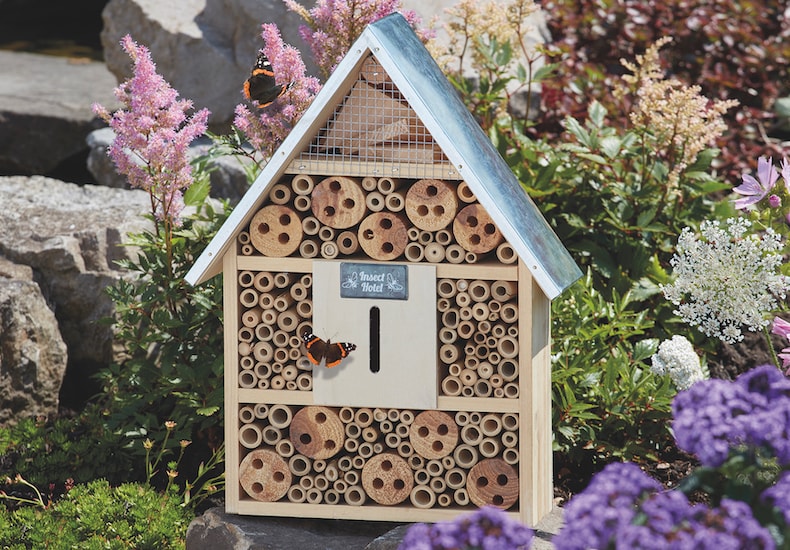How to encourage wildlife in your garden

A dedicated insect hotel is a great way to encourage wildlife into your garden
Image: Garden Life Wooden Insect Hotel from Thompson & Morgan
Our native wildlife is under pressure like never before - from loss of habitat, climate change and diseases such as those currently affecting bees. Even if you only have a small garden, there’s still plenty you can do to help. In fact, the combined area of all gardens in the UK comes to more than a million acres so every inch counts!
If you want to encourage hedgehogs, birds, butterflies, bees and insects into your garden, here are some top tips…
- Bring in the bees - The number of bees in the UK is declining at an alarming rate. It's thought that the loss of native and wild flower rich grassland could be a cause. To help save the bees, plant pollinator-friendly plants and flowers around your garden. If you don’t have much space, try containers of scabiosa or geums. Learn more about bees and their favourite habitats here.
- Give a hedgehog a home - Hedgehogs travel approximately one mile each night to forage for food, find shelter or search for a mate. Create a gap (15cm will do) in your fence or dig a channel underneath to help them on their way. You can put out ready-made hedgehog food, or try meaty dog food, mealworms, sunflower hearts and unsalted peanuts. See our purpose-built hedgehog homes here and read our guide to hedgehogs for more tips.
- Find room for flowers - It may seem obvious but don't forget to include plenty of colourful flowers to attract and feed butterflies and other pollinating insects. Almost all flowers will do (that’s what they’re for, after all) but some are particularly suitable. Browse our flower seeds for inspiration.
- Rethink your lawn - Grass is an important habitat for a host of insects which in turn provide food for birds and other animals. By avoiding the use of chemicals, leaving the grass a lttle longer (around 3 - 5cm) and mowing less often (say, every two weeks) you’ll encourage a healthy eco-system. Try keeping a border of long grass around the edge of your lawn to shelter grasshoppers, lacewings and ladybirds.
- Keep some dead wood - Leave a pile of dead wood in a shady spot to serve as a shelter for beetles and other insects.
- Plant a tree - You don’t need a big garden to plant a tree. In fact some will grow perfectly well in a large patio container. If you want to encourage birds to your garden, provide food, fresh water, secure vantage points and nesting sites (out of reach of cats!). See our collection of trees, including container varieties here.
- Hang some bird feeders - keep your bird feeders full and birds will come to know they can rely on you when natural food sources are scarce. Remember to clean your feeders regularly to avoid spreading disease. See our range of wild birdfood for high quality options.
- Dig a pond - Probably one of the most important things you can do for a thriving wildlife garden, even a small pond will attract dragonflies, birds, frogs, small animals and aquatic insects. Make sure animals can get safely in and out.
- Use natural pest control - Be more patient with pests! Try to avoid the use of chemicals - instead, encourage more of their natural predators with plants like chamomile, marigolds and hyssop. If you need to tackle a particular problem, try our range of natural pest controls.
- Grow your own manure - Growing green manures over winter helps maintain nutrients in the soil and prevents weeds from taking over. This reduces the need for weed killers or additional fertilisers.
- Plant a herb garden - Herbs like borage, chives, comfrey, fennel, hyssop, lavender, lemon balm, lovage, mint, rosemary and thyme all encourage beneficial insects into your garden. Take a look at our range of herb plants for ideas.
- Leave things alone - Leave a corner of the garden undisturbed and it will naturally become a haven for wildlife - what could be easier? If there are a few logs and old pots for shelter so much the better.
Looking for more information and advice about wildlife-friendly gardening? Visit our dedicated hub page for a wealth of helpful tips.
Sign Up For Exclusive Special Offers




© 2025 Thompson & Morgan. All rights reserved. A division of Branded Garden Products Limited.



